The iPad Air Review
by Anand Lal Shimpi on October 29, 2013 9:00 PM ESTiPhone to iPad: CPU Changes
Although the iPad Air uses the same A7 from the iPhone 5s (and M7 motion coprocessor), there are a few minor differences that do lead to better performance.
At a high level we’re still talking about two 64-bit Apple Cyclone cores with 128KB L1s (64KB I$ + 64KB D$) per core, a shared 1MB L2 cache and a 4MB L3 cache that services the entire SoC. Apple increased CPU frequency from 1.3GHz to 1.4GHz in the iPad Air, a mild increase but in line with what we’ve seen from previous iPad designs. That’s the first impact on performance - a 7.69% increase in CPU frequency.
The second impact on performance is something I only noticed while digging around under the hood of the A7. It seems like the implementation in the iPad Air can, for whatever reason, hold more instructions in flight (over 20% more) than the A7 in the iPhone 5s. It’s unclear to me whether the A7 in the iPad is configured any differently via firmware/microcode or if perhaps we’re looking at a slightly different revision of the core, but the delta was repeatable in my testing.
The third, and likely biggest change impacting the iPad Air’s implementation of the A7 is the additional thermal headroom afforded by the larger chassis. I’m not going to go into details on exactly what this next test does (unfortunately we’re going to occlude some of the low level work that we do in light of all of the benchmark cheating going on), but we’re looking at a curve of performance vs. time for a particularly power heavy mix of code. We’re running the same exact code on both the iPad Air and iPhone 5s here, the only real difference is the size of the chassis:
You can see the 5s throttles back its CPU frequency to about 1GHz after the 2 minute mark. The crazy thing is that until that point the 5s manages to run at full frequency without so much as a hiccup for two full minutes, running an incredibly power hungry task. Given that most iOS apps aren’t this power intensive for such a sustained period of time, iPhone 5s users should almost always see the A7 running at a full 1.3GHz. Pretty crazy.
The iPad Air by comparison shows much more controlled behavior. Early on in the test we see a 7.7% performance advantage, which lines up perfectly with the iPad Air’s 7.7% CPU frequency advantage. By the end of the test the iPhone 5s has throttled to 900MHz, while the iPad Air drops to around 1.2GHz. At this point the iPad Air’s performance advantage grows to almost 40%.
CPU Performance
I've gone through our standard set of cross-platform browser based benchmarks to place the iPad Air's performance in perspective. As I mentioned in our 5s review, I don't know that there are many (any?) applications on iOS 7 that can really take advantage of all the A7 has to offer. There's definitely a ton of headroom left in the design. What's particularly exciting is when the A7 ends up in n-1 or n-2 iOS devices and it becomes the minimum developer target going forward.
I won't go through all of the results here again, but it's safe to say that the iPad Air is the fastest ARM based tablet on the planet at this point.
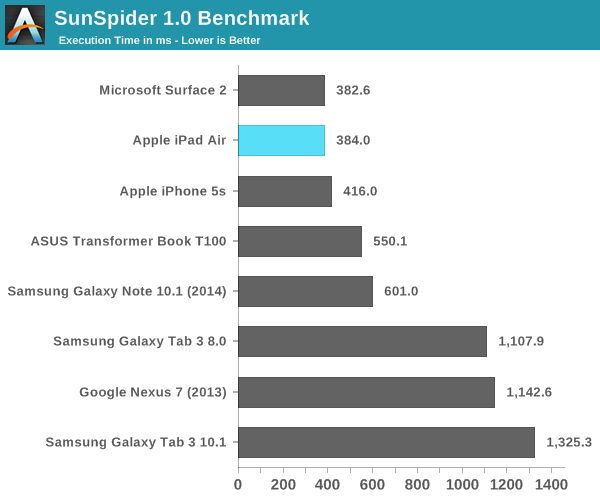
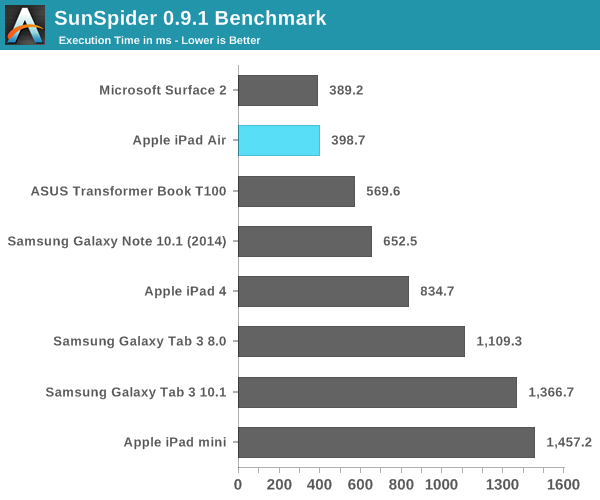
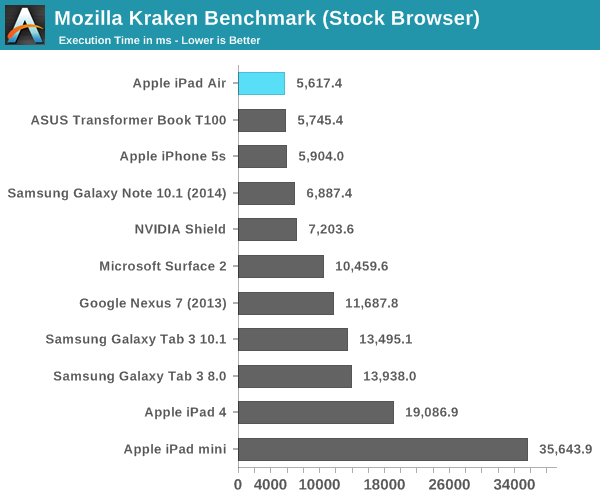
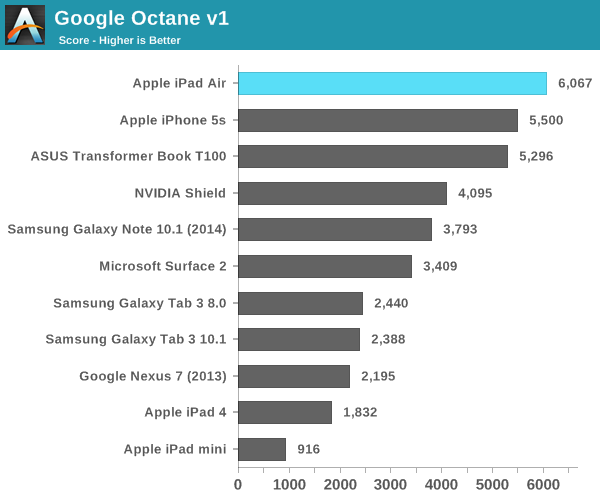
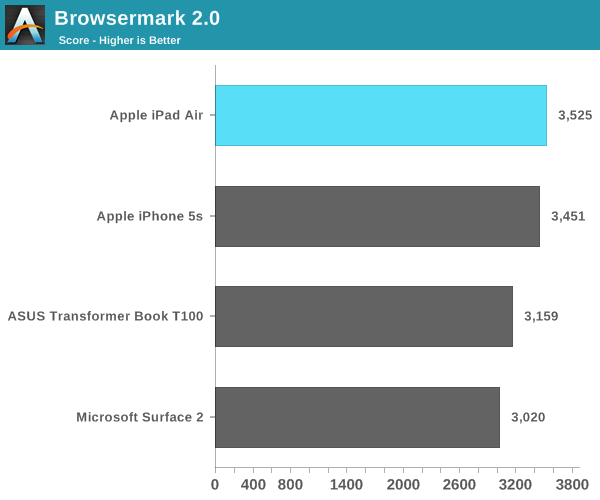

A7 Power Consumption
I’ll get to battery life in a bit, but I’ve been curious about the dynamic range of power consumption offered by Apple’s new A7 SoC. On the one hand we’re dealing with a lower power process (28nm vs. 32nm), but on the other hand Apple’s Cyclone cores can clearly draw more power given how beefy the architecture is this round. Apple frowns upon review sample dissection so I had to turn to a less scientific method of external platform level power measurement. The fidelity of the numbers here aren’t all that great but it’s better than nothing.
For the first test I measured platform power consumption during a Kraken run:
I purposely started measuring before the benchmark so I could get an idea of idle power consumption. The iPad Air consumes roughly 72% of the idle power as the iPad 4, both running at the same brightness. Here we’re not just seeing the A7’s advantages but also things like lower display power.
Focusing on the load portion of the measurement we see that both the new iPad and old iPad consume the same total power in this test. I suspect the A7 is drawing more power than the A6X, but it’s masked by a lower power display. Given how much faster the iPad Air is, Apple’s latest tablet features far lower overall task energy than the outgoing iPad 4. This is probably both the best case scenario for the iPad Air and the most likely case as well.
For kicks I wanted to see just how much power I could get the iPad Air to draw. Here I’m looking at platform power during our mini-power-virus test from above:
How’s that for dynamic range? Almost 12W running all out, but around half that in what we’d normally consider to be a stressful CPU test. I couldn’t get any actual applications/games on the iPad Air to behave like this so the results above are purely academic (for now). A quick run through GFXBench 2.7’s T-Rex HD test confirms that even pushing the GPU won’t hit these numbers. The max I saw running T-Rex offscreen was ~6W, and turning to an actual game (Infinity Blade 3) the iPad Air pulls less than 5W.


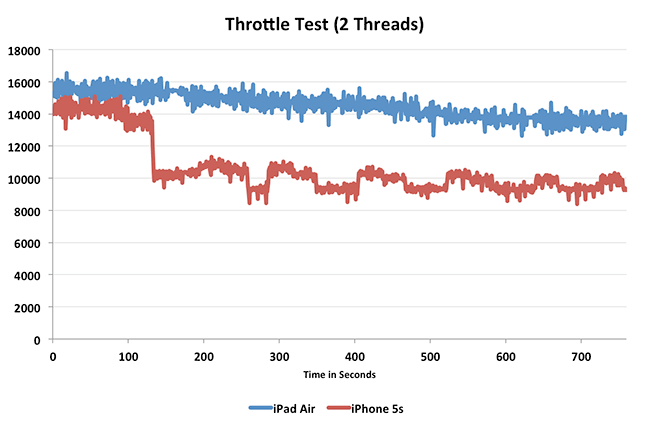
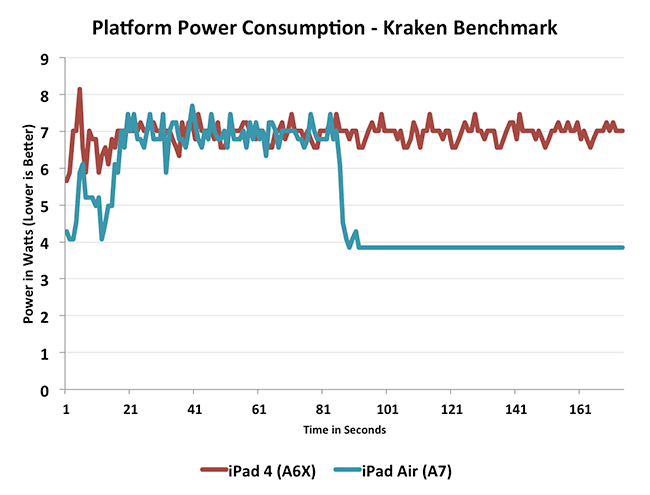
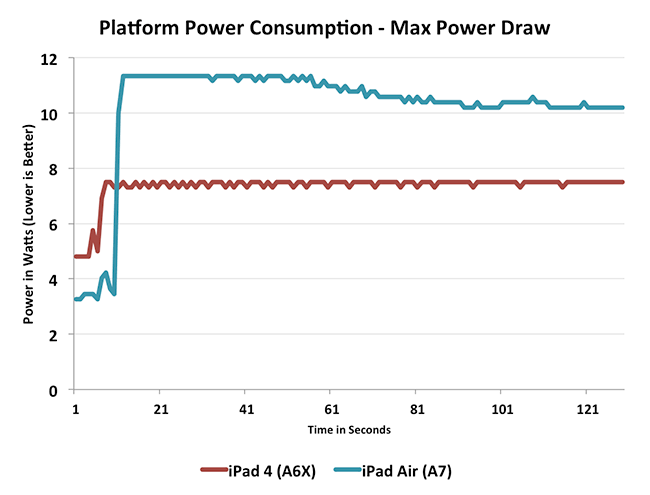








444 Comments
View All Comments
ssiu - Tuesday, October 29, 2013 - link
Still, when Apple claims "up to 2x GPU of iPad 4", usually you will find some aspect of GPU performance that reaches the 2x claim. "40% to 70% better" seem below expectation compared to the claim.MadMan007 - Tuesday, October 29, 2013 - link
Apple marketing slides vague, misleading, or contrived? NO WAI!FwFred - Wednesday, October 30, 2013 - link
With CPU power going up (eating into turbo/thermal headroom), I wonder where Apple is going to get their next 2x? TSMC/Samsung aren't moving fast enough for them. They have gone from toy CPUs to soon bumping against the limitations of physics.takeship - Wednesday, October 30, 2013 - link
My bet is on them shifting to Intel as a fab on their 16nm, but doing so prior to the A9 (2015) may be a stretch.tipoo - Tuesday, October 29, 2013 - link
How much does the GPU throttle? I was somewhat under the assumption that iPhones didn't have to throttle their CPUs as they never chased insane clocks like others (the infamous Nexus 4 throttling problem, also dialing back to 1GHz like here, not that the core performances are the same).errorr - Wednesday, October 30, 2013 - link
They still throttle it just takes longer. The other big advantage is just the pure SIZE of the chip which is what allows the lower clocks.Egg - Tuesday, October 29, 2013 - link
Can someone explain the extremely cold display? Is it not true that "closer to 6504k is better" anymore?Psyside - Wednesday, October 30, 2013 - link
Yes. Some people prefer over-saturated colors, 6500K is as closes to perfect as one can imagine, what he like or prefer is another story.For me 6500 sRGB displays are the only that matter, i can't stand 4500-5000K aka ARGB garbage.
cheinonen - Wednesday, October 30, 2013 - link
6504K is the reference standard, which is devised from the color temperature of daylight at a certain time (and latitude). Really, it's what colors will look like if you have them outside during a sunny day. During sunrise or sunset, or under clouds, the light spectrum is different, so you see things differently then.Getting a display to do 6504K is just that: making what you see on screen be what it looked like when it was shot or designed. If you want it to be warmer (for example, incandescent light bulbs are around 2700K which is a warmer reddish light) or cooler is a personal preference, but if its closer to D65 (the actual white point) it will be more neutral and accurate.
wiz329 - Tuesday, October 29, 2013 - link
What are your thoughts on the naming scheme @Anand?iPad Air is a pretty dumb name unless they're planning on releasing a Pro product.